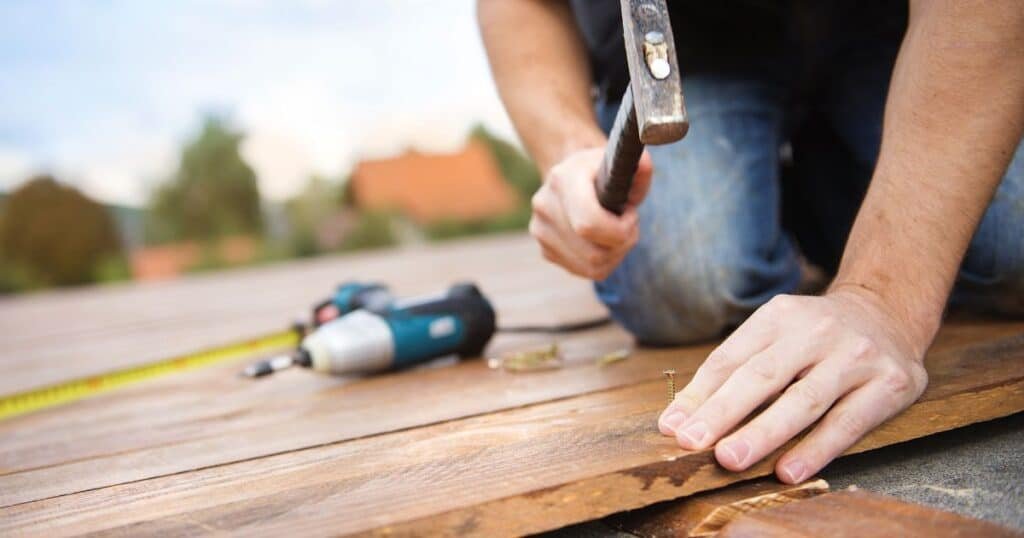In order to lay hybrid flooring, it is important to have a basic understanding of both the adhesive and the sub flooring.
Adhesive Hybrid Flooring uses an adhesive between the two layers of flooring. To ensure a good bond, it is important to use the correct adhesive for your flooring.
Once the adhesive has been applied, you will need to add a layer of sub flooring before installing your hybrid floor. This will ensure the flooring sits in a straight line when it is installed.
To install adhesive hybrid flooring, you will need to use a glue gun and an adhesive that is made for your type of floor.
The glue gun should be at least 3 inches long, and it should have a trigger. The adhesive that you use has to be the right type for your flooring.
What Is Hybrid Flooring And What Are The Benefits?
Hybrid flooring is a type of flooring that combines two or more different types of materials to create a unique look and feel.
The benefits of hybrid flooring include the ability to customize your flooring based on your needs, increased durability, and an overall easier installation process.
Hybrid flooring is perfect for users who want to have more control over their flooring and want to be able to change the look and feel of their room without having to replace the entire floor.
- How Much Does It Cost To Pigeon Proof Solar Panels
- How To Buy The Gel Bottle Without Certificate
- How To Make Weetabix
Materials And Installation
1.If you want to lay hybrid flooring, you’ll need the right tools and materials.

2.You’ll need a level, tape measure,T-bar clamp, utility knife, floor buffer or foam roller and a bucket for mixing adhesive.
3.First, mark the area where you’ll be installing the hybrid flooring with a level.
4.Then use the tape measure to make sure that the surface of your floor is perfectly level before cutting the T-bar clamp to fit your measurements.
5.Next, carefully attach the T-bar clamp to the wall or beam above your planned installation site and use the utility knife to cut a hole in it large enough for the T-bar clamp to fit through.
6. Then use the floor buffer or foam roller to remove any unwanted debris from the area you’ll be installing the hybrid flooring.
7.Finally, mix up a small amount of your adhesive with a bucket and then apply it evenly over the entire T-bar clamp.
8. Then, remove the excess from your T-bar clamp with a putty knife and wipe off any excess glue that remains on the floor.
9. Next, use the T-bar clamp to attach the hybrid flooring to your wall or beam.
10. Finally, make sure to use your screw gun to secure the hybrid flooring into place.
Step-By-Step Instructions For Installing Your Hybrid Flooring
1. Start by installing your hybrid flooring in the area you’d like to install it.
2.Next, apply the glue to the T-bar clamp and press into place over your T-bar.
3. Next, apply the glue to the top of your T-bar clamp and then press into place over the hybrid flooring.
4. Repeat steps 2 & 3 for each T-bar clamp that you are installing on your floor.
5. Next, connect your T-bar clamp to your hybrid flooring.
6. Finally, attach the bottom of your T-bar clamp over the bottom of your hybrid flooring.
Benefits Of Hybrid Flooring
Hybrid flooring is a type of flooring that is made up of two different materials. This means that the flooring has a surface that is both wood and tile.
There are many benefits to choosing hybrid flooring, and here are some of the key reasons why you should consider this type of flooring:
-Hybrid floors are durable: They can last for many years without needing to be replaced, which is great if you want to make your home more affordable.
-They are easy to care for: Unlike traditional wood or tile floors, hybrid floors don’t require any special cleaning techniques. You can just sweep them and mop them clean as needed.
-They look great: Whether you want a traditional wood or tile look in your home, hybrid floors can provide both options.
-They are easy to install: Unlike wood or tile floors, hybrid floors can be installed in less time than traditional flooring options.
This makes it a perfect choice for busy people who want to get their new flooring installed without taking up too much of their time and money.
What Are The Risks Of Laying A Tile Floor?
If you are considering laying a tile floor, be sure to weigh the risks against the benefits. Here are some key factors to consider:
-Tile is a durable and long-lasting flooring option, but it is also prone to scratches and other damage.
-It can be difficult to repair or restore a tile floor if it suffers damage.
-Tile can be difficult to clean, requiring special cleaners and techniques.
-It can be expensive to replace tiles that wear out or need repairs.
What Type Of Wood Is Used For The Flooring?
Choosing the right flooring for your home is important, not only because it will look great, but also because it can make a big difference in how comfortable you and your family feel.

There are many different types of flooring available, and each has its own unique features and benefits.
One of the most popular flooring options today is hybrid flooring. This type of flooring consists of two different types of materials, usually wood and tile or cement, which work together to create a durable and long-lasting surface.
Hybrid floors are very versatile and can be used in a variety of different settings, from indoor spaces like kitchens and bathrooms to outdoor areas like decks and patios.
There are a few things to keep in mind when choosing hybrid flooring: first, decide what kind of look you want for your room.
What Is The Difference Between A Hardwood And A Bamboo Floor?
A hardwood floor is a traditional, solid wood floor that is usually installed in areas of high traffic. Hardwoods are dense and heavy, so they can take a lot of wear and tear over time.
Bamboo floors are made from bamboo stalks that have been processed into strips or squares. These strips are then laid down like a sheet of paper and bonded together with natural adhesive.
Bamboo floors are much lighter than hardwood floors, which makes them more flexible and easier to move around. They also tend to be less expensive than hardwood floors, though they may not last as long.
How Do You Lay A Bamboo Floor?
Bamboo flooring is a great option for people who are looking for sustainable flooring options. It is made from bamboo, a renewable resource, and it is easy to install. Here are eight steps on how to lay a bamboo floor:
1. Measure your room and choose the right size of bamboo flooring. Be sure to account for any furniture or doorways that will need to be taken into account when choosing the right size.
2. Pre-drill holes in your bamboo flooring using a handheld drill with a ¼ inch bit or use the installation instructions that came with your flooring. Make sure to countersink the hole if you are using a handheld drill so that the screw doesn’t come out of the wood surface.
3. Cut your bamboo flooring to the desired length and width.
4. Lay your bamboo flooring on a flat surface such as hardwood floor, concrete or a tile floor.
5. Use a rubber mallet or hammer to tap in the pre-drilled holes in your bamboo flooring.
Final Thoughts
When it comes to flooring, there are a few things to keep in mind. First, hybrid floors are a great option for people who want the look and feel of both wood and tile. They’re also easy to care for – all you need is a vacuum cleaner with a crevice tool.
Second, consider your budget when choosing hybrid flooring. Not all hybrids are created equal – some are more expensive than others. And, if you have pets or children who like to play on the floor, be sure to choose a hybrid that’s resistant to scratches and stains.
Finally, be sure to ask your flooring installer about any special installation tips or considerations related to hybrid floors. They may have experience with this type of flooring and can help ensure that your project goes smoothly.

